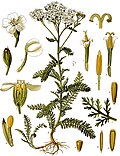Achillea millefolium
Achillea millefolium[edit]

Achillea millefolium, commonly known as yarrow, is a flowering plant in the family Asteraceae. It is native to temperate regions of the Northern Hemisphere in Asia, Europe, and North America.
Description[edit]
Achillea millefolium is a herbaceous perennial plant that typically grows to 0.2–1 m tall. The leaves are 5–20 cm long, bipinnate or tripinnate, and almost feathery, giving the plant its common name, "millefolium," meaning "thousand leaves."

The plant produces one to several stems and has a spreading rhizomatous growth form. The flowers are produced in dense, flat-topped clusters, each flower being 5 mm in diameter, with white to pink petals.
Habitat and Distribution[edit]
Achillea millefolium is found in a variety of habitats, including grasslands, meadows, and open forests. It is adaptable to different soil types and can tolerate drought conditions. The plant is often found in disturbed areas and is considered a pioneer species.
Uses[edit]
Achillea millefolium has been used traditionally in herbal medicine for its purported anti-inflammatory and wound-healing properties. It is also used in aromatherapy and as an ornamental plant in gardens.

Cultivation[edit]
Yarrow is easy to grow and requires minimal care. It prefers full sun and well-drained soil. The plant can be propagated by seed or division. It is often used in xeriscaping due to its drought tolerance.
Related Species[edit]
Achillea millefolium is part of the genus Achillea, which includes several other species such as Achillea ptarmica and Achillea filipendulina.
Related Pages[edit]
Gallery[edit]
-
Illustration of Achillea millefolium
-
Close-up of flowers
-
Pollinator on yarrow
-
Red variety of Achillea millefolium
-
Achillea millefolium in a garden
-
Close-up of leaves
-
Yarrow stalks used for I Ching
-
Achillea millefolium
-
Achillea millefolium
-
Achillea millefolium
-
Achillea millefolium
-
Achillea millefolium
-
Achillea millefolium
-
Achillea millefolium
-
Achillea millefolium
-
Achillea millefolium
-
Achillea millefolium
Ad. Transform your life with W8MD's Budget GLP-1 injections from $75


W8MD offers a medical weight loss program to lose weight in Philadelphia. Our physician-supervised medical weight loss provides:
- Weight loss injections in NYC (generic and brand names):
- Zepbound / Mounjaro, Wegovy / Ozempic, Saxenda
- Most insurances accepted or discounted self-pay rates. We will obtain insurance prior authorizations if needed.
- Generic GLP1 weight loss injections from $75 for the starting dose.
- Also offer prescription weight loss medications including Phentermine, Qsymia, Diethylpropion, Contrave etc.
NYC weight loss doctor appointmentsNYC weight loss doctor appointments
Start your NYC weight loss journey today at our NYC medical weight loss and Philadelphia medical weight loss clinics.
- Call 718-946-5500 to lose weight in NYC or for medical weight loss in Philadelphia 215-676-2334.
- Tags:NYC medical weight loss, Philadelphia lose weight Zepbound NYC, Budget GLP1 weight loss injections, Wegovy Philadelphia, Wegovy NYC, Philadelphia medical weight loss, Brookly weight loss and Wegovy NYC
|
WikiMD's Wellness Encyclopedia |
| Let Food Be Thy Medicine Medicine Thy Food - Hippocrates |
Medical Disclaimer: WikiMD is not a substitute for professional medical advice. The information on WikiMD is provided as an information resource only, may be incorrect, outdated or misleading, and is not to be used or relied on for any diagnostic or treatment purposes. Please consult your health care provider before making any healthcare decisions or for guidance about a specific medical condition. WikiMD expressly disclaims responsibility, and shall have no liability, for any damages, loss, injury, or liability whatsoever suffered as a result of your reliance on the information contained in this site. By visiting this site you agree to the foregoing terms and conditions, which may from time to time be changed or supplemented by WikiMD. If you do not agree to the foregoing terms and conditions, you should not enter or use this site. See full disclaimer.
Credits:Most images are courtesy of Wikimedia commons, and templates, categories Wikipedia, licensed under CC BY SA or similar.
Translate this page: - East Asian
中文,
日本,
한국어,
South Asian
हिन्दी,
தமிழ்,
తెలుగు,
Urdu,
ಕನ್ನಡ,
Southeast Asian
Indonesian,
Vietnamese,
Thai,
မြန်မာဘာသာ,
বাংলা
European
español,
Deutsch,
français,
Greek,
português do Brasil,
polski,
română,
русский,
Nederlands,
norsk,
svenska,
suomi,
Italian
Middle Eastern & African
عربى,
Turkish,
Persian,
Hebrew,
Afrikaans,
isiZulu,
Kiswahili,
Other
Bulgarian,
Hungarian,
Czech,
Swedish,
മലയാളം,
मराठी,
ਪੰਜਾਬੀ,
ગુજરાતી,
Portuguese,
Ukrainian









